General Information
back to HOME
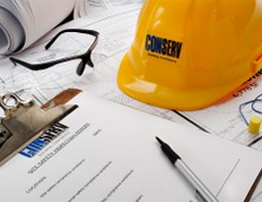

back to HOME



QC’s Building Services is a family owned and operated business, who specialize in carrying out Building & Timber Pest Inspections on residential properties. The company was started around 17 years ago and is owned and operated by Ryan Craig.
Ryan has been with QCs Building Services since 2002 and as the business’s consultant has carried out thousands of Residential Property Inspections on units, townhouses and houses. Ryan is supported by his wife Cindy who controls the ‘engine room’ and ensures that all clients receive a service that is second to none.
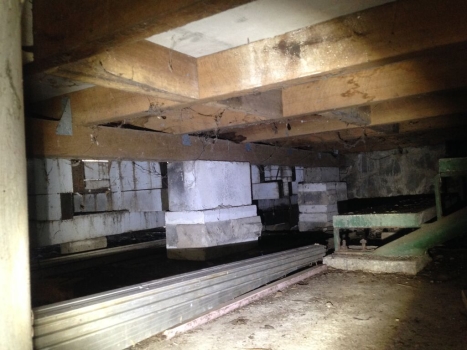
It is almost without exception that when we come across non-compliant and informal building work it has been carried out in a manner to provide termites an opportunity to thrive, feed and potentially gain access to other areas of the structure.
This is because incorrect materials, which are termite susceptible, are normally used and are put in areas where they shouldn’t be and there is a lack of termite control measures in place.
All new construction should be carried out in accord and in complete adherence with the relevant legislation, Australian Standards and Building Codes. Where it has been identified that building work is informal, or non-compliant, termite control measures should be installed, in order to try and overcome the increased risks associated with such practices.
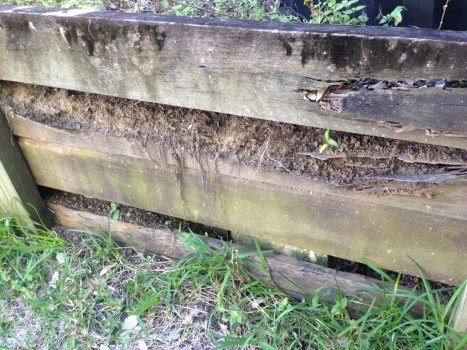
Often during the course of an inspection we will identify certain landscaping and construction practices which have created an environment of opportunity for termites to either gain access to the structure, or simply feed on a material that should not have been used within the environment it was placed within. Common examples of this can be where mulch is installed within the block of the hoop pine variety. Hoop pine may be aesthetically desirable however it is very vulnerable to termite attack and should be avoided as a mulch within the block. The smarter choice would be to install a mulch of the Cypress Pine variety, as this timber is known to have qualities that make it resistant to termite attack.
Another issue is where untreated pine timbers are used for subfloor or storage/exterior areas and are fixed directly to concrete slab areas without any form of antcapping of protection. Using untreated timbers in areas of exposure to the elements (rain, sun and lack of ventilation etc) results in the advanced and rapid deterioration of the timber, which makes it extremely attractive to termites. Even without any deterioration, it would have already been simply a matter of time before the timber would have been attacked by termites. Untreated pine timbers should never be used in any exposed or exterior area. The photo provided below shows what can happen when the material is installed where it shouldn’t be.
Even where materials are used that have been treated via CCA methods (copper, chrome and arsenate), particularly in exposed landscaping areas e.g. fences and retaining walls, termite attack still occurs and in some cases can be within a few years from the material being installed. The photo below shows a retaining wall that has been badly compromised by termite activity and is one that was a H4 treated wall. This seems to be particularly prevalent for hardwood timbers and we believe the reason for this is that the durability and strength of the hardwood timber does not allow it to be fully treated at the time of milling, as the CCA does not reach the inner core of the timber. Once in situ and exposed to the elements the timber will naturally deteriorate and open/split etc. This will expose any untreated areas and from there make it vulnerable to potential termite attack.
Retrospectively treating retaining walls and fence timbers via termiticide application when they are in service is extremely difficult, and this is referred to within the Australian Standard for Termite Management AS3660. In all cases the best scenario, despite it being initially more expensive, would be to use termite resistant materials for landscaping e.g. 50mm x 50mm steel posts for fencing and masonry blocks, or like, for retaining walls.
In recent years the use of ant capping as a primary termite control measure has significantly declined, as the newer termite controls have superseded it. For construction right up until the late 1990’s it was however considered vital in terms of its benefits and use as a termite control measure and it certainly hasn’t been eliminated altogether. In fact in certain circumstances it can compliment a primary physical or chemical termite control very well.
The product is normally of a galvanised metal variety and it is designed to be placed in areas of a structure to prevent termites gaining access. Such areas can include atop concrete and timber stump isolated pier footings, on top of brick wall strip footings and at the base of exterior cladding.
The use of ant capping in sub-floor areas, for construction of the post war, slightly elevated structures built during the 1950’s, 1960’s and 1970’s is normally where we see most corrosion and deterioration of the material. Clearly, when it becomes rusted and is incomplete in parts, it becomes ineffective as a termite control measure as it potentially allows access to the structure via the areas of deteriorated ant capping.
Retrospectively fitting ant capping in some areas is a difficult and almost impossible task, as it involves trying to install the material beneath in situ framing members which are carrying significant live and dead loads (usually bearers and bottom plates). Instead of replacing the deteriorated ant capping, the easier option would be to apply a chemical termiticide where the ant capping is no longer effective.
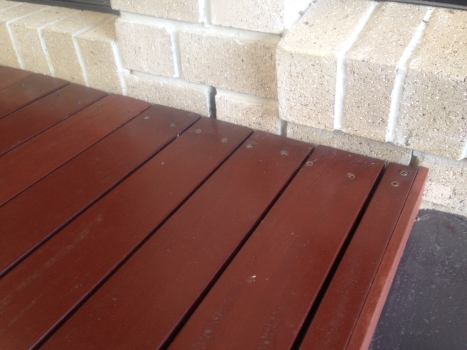
Weep holes in structures, particularly brick veneer properties, play very important roles, as they provide a facility for the structure to ventilate and discard any excess condensation or moisture within the wall cavities. They should never be either partially or completely concealed, as this would obviously compromise their intended function. It would also provide an opportunity of concealment for any foraging termites to potentially enter the structure. Unfortunately we identify concealed weep holes on many occasions during the course of an inspection and some of the factors which create concealment include: render covered weep holes, rainwater tanks, air conditioning condensers and weep holes covered by retrospective landscaping e.g. concrete paths, garden beds, vegetation and in more recent times platform style decking.
To avoid the risks of concealed termite entry into any structure it should be considered absolutely essential that every weep hole within the exterior brickwork is free from concealment and clearly visible for inspection at all times.
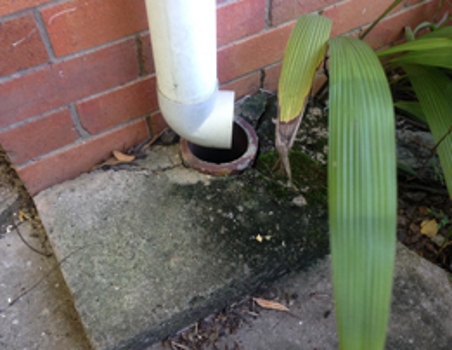 All too often during our inspections we identify areas which are conducive to the collection of retained ground moisture near a structure. Elevated moisture levels are known to provide conditions favourable to Timber Pest activity, particularly termites, and it is vital that every effort be made to avoid these risks. The most common causes of retained ground moisture are inadequate surface water drainage, downpipes not connected to drainage outlets, no gutters in place for roofing areas, outlet pipes for air conditioners, relief and overflow valves for hot water cylinders, corroding and join leakages of gutters and downpipes, defective or incomplete flashing and plumbing for rainwater tanks leaking. These are all issues which can be, and should be rectified, if they are in existence at a property.
All too often during our inspections we identify areas which are conducive to the collection of retained ground moisture near a structure. Elevated moisture levels are known to provide conditions favourable to Timber Pest activity, particularly termites, and it is vital that every effort be made to avoid these risks. The most common causes of retained ground moisture are inadequate surface water drainage, downpipes not connected to drainage outlets, no gutters in place for roofing areas, outlet pipes for air conditioners, relief and overflow valves for hot water cylinders, corroding and join leakages of gutters and downpipes, defective or incomplete flashing and plumbing for rainwater tanks leaking. These are all issues which can be, and should be rectified, if they are in existence at a property.
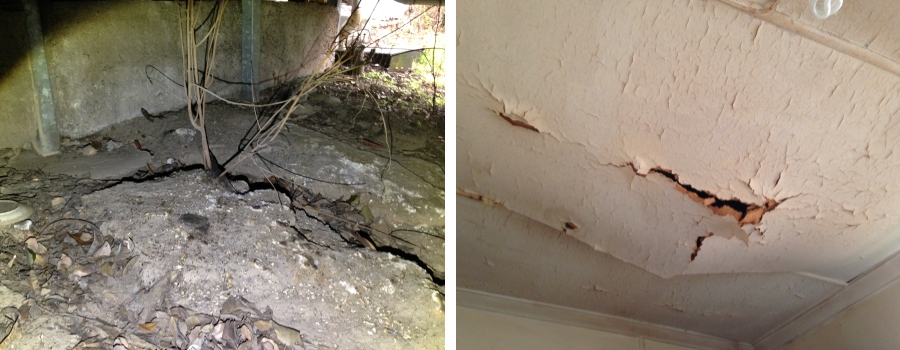
Water is obviously such a vital need for us, in terms of our survival, but ironically and in terms of building materials, it can be completely devastating if it gets to areas it shouldn’t be, and in contact with materials not designed to be in contact with water. The most common areas of ingress are the subfloor (normally caused by a lack of adequate drainage), the interior (again can be by lack of drainage where higher exterior ground levels are in place, poor sealing and flashing around the window and door openings in the exterior of a structure, wet area leaks and roof leaks). Some common damage water exposure can cause to materials is service are rusting, swelling, decaying and in the cases of electrical and cable services can completely destroy the product.
The Australian Standard for Residential Building Inspections states, within as per section 4.2.4.1, Table 3.3 ‘Types of Defects’, that water penetration and damp related issues, that are present in unintended or unexpected locations shall be identified within a report as a Major Defect. The Queensland Building Construction Commission classes any water permeation into a structure as a ‘Category 1’ defect i.e. significant.
Over the years and during the course of inspections we have been continually exposed to seeing the damage and effect water exposure can have upon materials. The normal causes are poor drainage, inadequate flashing, wet area leaks and roof cladding leaks. We can’t stress enough how vital it should be considered by all property owners to make sure their property is absolutely water proof at all times and that there are the best possible surface/storm water drainage systems in place and that both aspects of these water deterrents are regularly inspected and repairs carried out where deemed necessary.
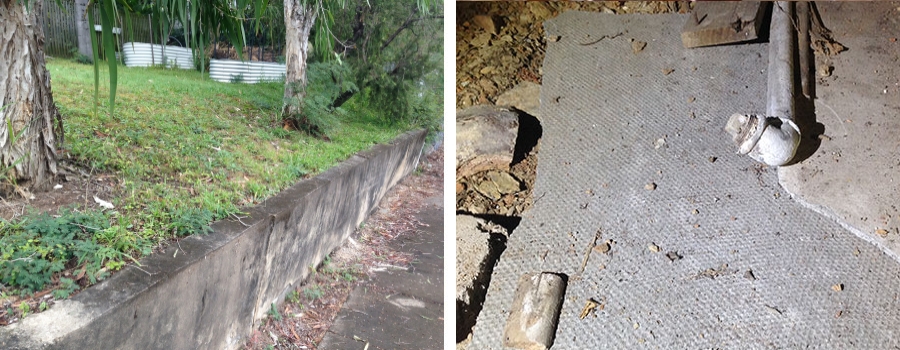
The Australian Standard for Residential Building Inspections has a major focus on defects which can cause unsafe environments and potential harm to people. There are some very common ones we come across on a regular basis during our inspections and these include:
In the cases of structures built before the introduction of the Building Code of Australia (1996), and any relevant Australian Standards pertaining to an area of safety risk, there may be no obligation on a property owner to upgrade to the most modern standard of safety requirements. This is because the house was built prior to the current rigidness and almost ‘over the top’ requirements of today’s safety standards. Examples of this can be where older houses may contain glass that is not of a safety variety, where balustrades are lower than required and have gaps larger than acceptable, where there are stairs in place that don’t have handrails etc. The issue can be however that if any accident occurs in an older structure, and involves an area where the accident was caused by building practices that do not comply with today’s requirements, the legal system would view the situation very dimly and probably rule against the owner in the event of the claim, notwithstanding the fact that there was no legal requirement to have the most modern safety standards in place. This is because any property owner has a common law ‘Duty of Care’ responsibility to ensure they provide the best possible environment of safety levels at their property and this includes having all modern safety standards complied with. This has been determined by various legal precedents in recent years.
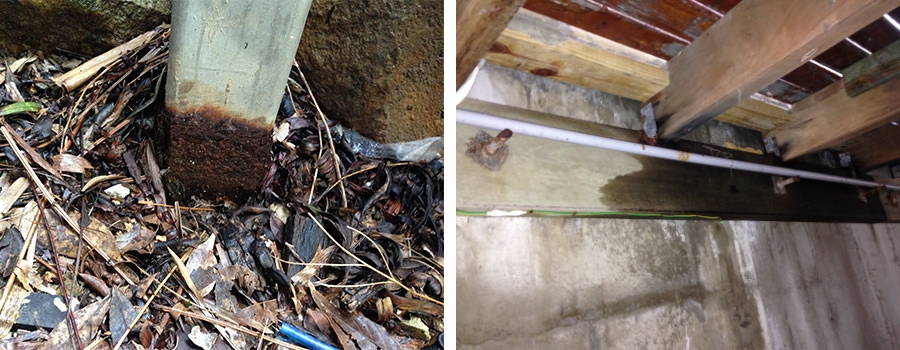
Corrosion is commonly found during our inspections in many different materials e.g. steel columns, beams, fasteners, roof cladding, plumbing pipes and hardware etc. The level of corrosion will vary dependent on type of metal – prime coated only steel will corrode faster than galvanised metals and on other factors like exposure to elements, particularly water. We also find corrosion is more severe when metals are used near salt water pools, as the photos included demonstrate, as one is of a deck area abutting a pool showing the corrosion to the fasteners and framing anchors.
Another common cause of corrosion is where two metals are used in a structure where they shouldn’t be in contact with one another and this creates what is known as a ‘galvanic reaction’ and subsequent corrosion. The table below, taken from part 3.5.1.2 of The Building Code of Australia lists some incompatible metal roofing combinations, which if not followed vigilantly, will certainly result in rusting occurring.

It is not possible to determine the full extent of corrosion at our level of inspection – visual only and to determine this more thorough, invasive inspection type techniques are necessary. In some cases, subject to the level of rust present, it may be possible to treat an affected area by way of wire brushing or similar cleaning technique and then coating on a zinc rich paint or applying an anti-corrosive coating such as a bitumen based waterproofing material. Where it is identified this is not possible, during the course of an invasive inspection, as a result of advanced rust, replacement will need to be carried out, especially where the steel material is providing some sort of structural or safety function.
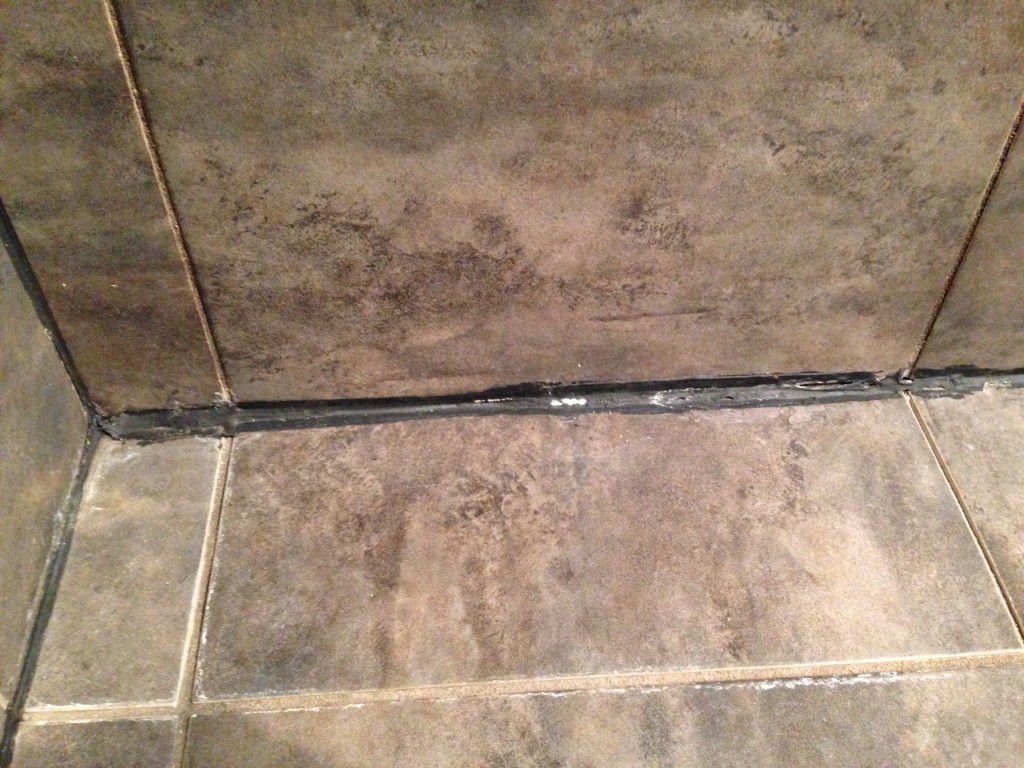
WET AREAS includes rooms within a building that are supplied with water from a water supply system e.g. bathrooms, en-suites, separate toilets and laundries, shower cubicles, which also include showers over baths, and other wet areas can allow moisture to absorb through their containment area via tiles and grout, deteriorating silicone, worn tap washers and/or o-rings, leaks from pipe connections including waste outlet, poorly or un-siliconed tap penetrations or stress fractures in the pipes themselves. Showers and other wet areas which have not been in use for sometime e.g. vacated premises, new dwellings or recently renovated areas may not reveal any initial signs of leaking as moisture may only penetrate vulnerable areas when taps are flowing and in some cases it can take several weeks for the moisture to absorb into concealed material before becoming visible in open and accessible areas. Since 1996, waterproofing of wet areas has been governed by the relevant Australian Standard AS:3740 (Waterproofing of Wet Areas). During construction any work to wet seal an area must be done by a QBCC licensed contractor (Waterproofer). This type of work is done to any leaks are contained and in the event of a failure and the moisture is guided to a drainage outlet. For homes built since 1996, a certificate to the owner normally via the builder would be provided by the contractor that all wet areas have been waterproofed in accord with the required Standard. In many cases, moisture absorption from a wet area (bathroom, separate toilet and laundry) is not visually recognised except in extreme cases with obvious signs on accessible surfaces, e.g. wet floor, floor coverings, distortions on wall linings, tile discolouration etc. The photo shown is an example of poorly carried out silicon application, with gaps visible which will allow moisture to escape the shower cubicle and cause resultant material damage.

The Australian Standard AS:3500-3 (2015) ‘Stormwater Drainage’ and the Building Code Australia (part 3.1.2) both demand that surface water not be collected/retained near the building line, rather it should be directed away at all times. AS4349.1 – 2007 (Standard for Residential Building Inspections) states, within Table 3.3 ‘Types of Defects’ that water penetration and damp related issues, that are present in unintended or unexpected locations shall be identified within a report as a Major Defect (as per section 4.2.4.1). Retained ground moisture can cause several problems for structures, including foundation movement and resultant cracking and is also known to be attractive to termites. As such all efforts must be taken by all property owners to ensure the collection of any moisture is minimised by having effective drainage in place. The photo shown is an example of what effect inadequate drainage can have on materials.
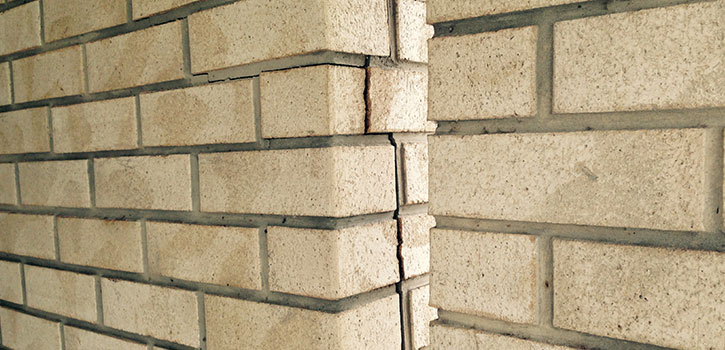
There are several reasons for cracks to occur in these areas and in fact cracking is extremely common. This is because we mostly build on reactive clay foundation material which will swell with rainfall and shrink without rainfall. As masonry is an inflexible material there is no opportunity to move with the ground and cracks can result. Modern building practices have improved, with the installation of expansion and articulated joints, and this has lessened the amount of cracking in more modern construction, but not eliminated it. There are also many other reasons which could be causing cracking, including rusting of reinforcement steel, inadequate footing design, surcharge of ground and material failure. The photo included shows an example of cracking in a masonry wall. Cracking in exterior areas of structures, particularly near window and door openings, are also commonly found during our inspections, as these are the weakest part of an exterior portion of a building. Whether or not future cracks or enlargement of existing cracks will occur can’t be determined by an inspection and one off assessment. This could only be conclusively determined by monitoring the crack(s) in the future as time passes. With all cracks identified we are legally obliged to recommend, as part of our Duty of Care obligations, that our clients immediately engage the services of a Registered Professional Engineer of Queensland. There is an Australian Standard which governs the assessment and classifies damage categories of cracks in masonry and this is AS2870 -2011 ‘Residential Slabs & Footings’

AS4349.1 – 2007 (Australian Standard for Inspections of Buildings – Residential Buildings) states the following in section 2.3.5:
Significant items to be reported are as follows:
The photo shown is an example of how balustrades can be unsafe as baluster members come away from the rail, normally because an undersized ‘Brad’ type nail is used. Other causes can be deterioration of timber and steel and rails for balustrades coming away from the post(s), again due to undersized fasteners being used.
While providing advice to clients on new building work and commenting on any formality of the same, is not required under the Australian Standard, at QC’s Building Services we don’t believe that not identifying any visually obvious new building work is an acceptable level of service. Where we identify possible extensions and modifications during the course of an inspection we will alert our clients and advise them to obtain further information regarding whether or not the work has been done in an approved and completed manner i.e. has the work obtained a Building Approval with plans stamped ‘approved for construction’ and has the work undergone the three mandatory inspections during construction (footings, frame and final). Obviously where we identify work which is clearly of an ‘ad-hoc nature’ this is also reported accordingly in our reports. Any building work carried out, which requires an approval as per the stipulations of the Building Act/Regulations, that has not been formally done and received a final inspection certificate can have major implications for property owners. For instance in the area of insurance, some insurance providers state on their Product Disclosure Forms that rejection of a claim will occur if unapproved building work has been carried out at a property. It also adds a complexity and difficulty when selling, as some buyers simply don’t want to get involved where unapproved work is in existence and withdraw from purchases for this reason. Obtaining retrospective certification can be extremely difficult, as for legal reasons, many certifiers will not take on completed work which requires final inspection certificate. There are also many requirements to fulfill to achieve a final inspection and a plethora of forms to provide under the requirements the Building Act (e.g. form 15 – compliance form for design&form 16 contractor’s form certifying their work).
When a Residential Building is constructed in Queensland it is a requirement for there to be Termite Controls Measures installed, in order to impede concealed termite entry into the structure post construction. These requirements are listed in the Building Code of Australia, part 3.1.3 ‘Termite Risk Management’ and the Australian Standard for Termite Management AS: 3660.1 (Termite Management – New Building Work). From the 1960’s until about 1995 the predominant form of termite control was the application of an organochlorine chemicals and these included the likes of Heptachlor, Aldrin, Dieldrin and Chlordane. These were banned in 1995, as they are inorganic compounds and were harmful to the environment. From that time until about 2006, more environmentally friendly chemicals were applied however these only had a very finite life time. Depending on the termiticide applied in that period, of which there were four available (Chlorpyrifos Bifenthrin Fipronil & Imidacloprid) a protection period of between 2 – 10 years maximum was available. This meant there were situations arising where new houses were being built in 1995 and the termite protection installed at the time of construction was expiring very shortly after. To compound this, there is no statute or law requiring any owner of an existing structure to replenish an expired treatment. Having no termite protection around a property doesn’t mean that it will sustain concealed termite entry and resultant timber damage but clearly it increases the risks of this considerably. All property owners should ensure that their property has current and adequate termite control measures at all times to provide the best possible levels of protection.
Around the late 1990’s – early to 2000’s newer ‘physical’ and mostly non-chemical termite controls measures entered into the market and examples of these include stainless steel mesh, crush rock, PVC and crushed glass. These types of termite controls had a much better design life when compared to the chemical ones available.
On 1.5.2006 the Building Code of Australia was amended with a Queensland variation, which requires a termite management system, not able to be replenished or replaced, to have a design life of at least 50 years. This means that any home built pursuant to a building approval issued from 1.5.2006 where a concealed and inaccessible termite management system is used (e.g. stainless steel mesh, impregnated fabric, collars around pipe penetrations, granular materials such as granite/glass etc), the building certifier issuing the building approval must be satisfied with documentation provided by the supplier such as a Registered Testing Authority report, Certificate of Conformity or a Current Certificate of Accreditation confirming that the system to be used during construction will have a design life of 50 years.
We have been using Ryan Craig for many years, and myself and my husband have been very happy with his services. His reports and detailed and he provides, clear and honest feedback about the properties that we have purchased, or have intended to purchase.
We recommend him every week to our clients and we have never heard a bad word about him. We have been able to use many of his reports to renegotiate price or terms in a contract.
We do happily and confidently refer business to him every week.
Kelly Cameron-Tull
Director – Get Real Finance
As a solicitor I have referred clients to Ryan Craig of QCs Building Services for over 12 years. I have always found Ryan to be professional, courteous and prepared to go the extra mile for his clients.
Graham Isles
Principal – Graham Isles & Associates Solicitors